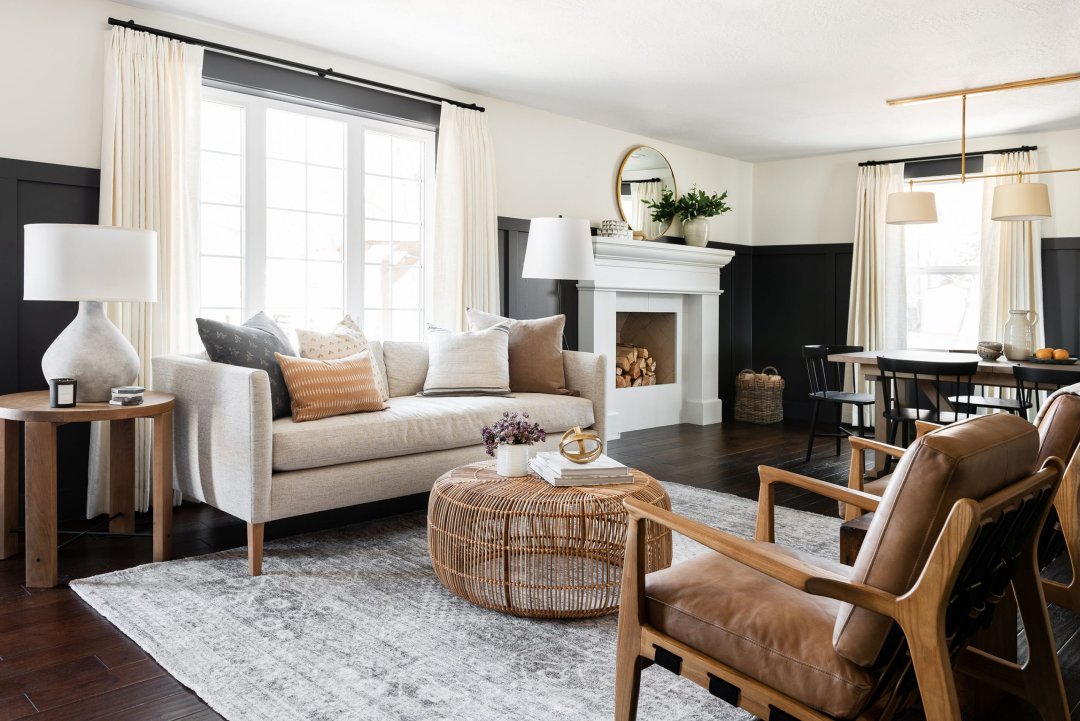Stylish Interior Design for Any Home crafting an environment that feels both current and comfortable is within everyone’s reach. By blending thoughtful planning with artful detail, you can achieve stylish design for homes regardless of size, budget, or architectural quirks. This guide unfolds expert strategies, practical tips, and unexpected techniques—interspersing brisk statements with more expansive explorations—to help you transform any space into a haven of lasting style.

Establishing a Cohesive Vision
Every great interior begins with clarity of intent.
- Define your core objective: Do you seek tranquility, vibrancy, or a balanced fusion?
- Gather inspiration: Assemble swatches, photographs, and magazine tear-outs into a mood board.
- Pinpoint signature elements: Identify one or two standout pieces—an heirloom coffee table, a bold area rug, or an avant‑garde light fixture—to serve as anchors.
Short sentence. A coherent vision prevents the design from meandering and ensures all decisions align toward stylish design for homes that feels purposeful rather than haphazard.
Mastering the Art of Space Planning
Functionality underpins style. Planning your layout meticulously avoids wasted corners and traffic jams.
- Zoning: Allocate dedicated areas for lounging, working, dining, and circulation.
- Measurements: Record wall lengths, window placements, and door swings before buying furniture.
- Mock‑ups: Use painter’s tape to outline furniture footprints on the floor for real‑world testing.
Longer sentence to emphasize how visualizing traffic flow and sightlines fosters both comfort and a polished appearance.
Building a Refined Color Palette
Color sets mood and unifies disparate elements.
- Neutral Foundation: Start with soft neutrals—warm alabaster, greige, or stone gray—to create a versatile canvas.
- Accent Hues: Choose one or two bold colors—emerald green, terracotta, or indigo—to enliven focal points.
- Metallic Touches: Polished brass, aged bronze, or matte black hardware adds refined punctuation.
Short. Then detailed: rigorous restraint in hue selection ensures a harmonious backdrop for textured fabrics and eclectic accents, hallmarks of stylish design for homes.
Elevating Textures and Materials
Tactile variety keeps interiors from feeling one‑dimensional.
- Natural Fibers: Jute rugs, wool throws, and linen draperies impart organic warmth.
- Solid Surfaces: Marble countertops, walnut floors, and exposed brick walls lend enduring character.
- Metal Accents: Copper pendant lights or iron-framed mirrors introduce a refined industrial edge.
By interlacing plush fabrics with structural elements, you achieve a sensory-rich environment that speaks to luxury without excess.
Strategic Furniture Selection
Choose pieces that balance scale, comfort, and aesthetic gravitas.
- Low‑Profile Seating: Sofas with slender arms and exposed legs maintain an airy feel.
- Multi‑Functional Units: Ottomans with hidden storage, nesting side tables, or wall‑mounted desks maximize versatility.
- Statement Anchors: Invest in one hero piece—a sculptural armchair or a bespoke credenza—to infuse personality.
Short. Longer sentence: thoughtful furniture curation ensures each item not only serves its purpose but also contributes to a cohesive narrative of stylish design for homes.
Illuminating with Intention
Lighting defines ambience and highlights key features.
- Layered Approach: Combine ambient, task, and accent lighting for depth and flexibility.
- Dimmer Controls: Adjustable brightness transforms the same space for work, relaxation, or entertaining.
- Feature Fixtures: A sculptural chandelier or a series of pendant lamps can double as artwork.
This multitiered strategy ensures every nook is both functional and atmospheric, enhancing the overall sense of sophistication.
Incorporating Bold Accessories
Accessories are the punctuation marks of design.
- Oversized Art: A large-scale painting or photograph anchors walls and injects drama.
- Eclectic Vignettes: Group objects in odd-numbered clusters on consoles or shelves for visual interest.
- Textural Accents: Ceramic vases, woven baskets, and artisanal sculptures introduce tactile contrast.
Short sentence. Detailed elaboration: rotating accessories seasonally or thematically keeps the space feeling fresh and underscores your confidence in stylish design for homes.
Layering Rugs and Flooring Treatments
Well-chosen floor coverings unify furnishings and add warmth.
- Layered Rugs: A smaller patterned rug atop a neutral sisal base creates depth.
- Graphic Carpets: Bold geometric or abstract motifs can define seating areas.
- Hardwood Variation: Mix plank widths or finishes across zones for subtle delineation.
By treating floors as integral design planes, you reinforce cohesion and invite exploration of texture underfoot.
Window Treatments: Framing the View
Drapery and blinds balance privacy with light.
- Floor‑to‑Ceiling Curtains: Mount rods high to emphasize height and swing panels wide for full exposure.
- Sheer Layers: Combine opaque panels with translucent voiles for versatile diffusion.
- Minimalist Shades: Roller or Roman blinds in natural weaves maintain a seamless look.
Short. Longer: carefully detailed window treatments contribute to stylish design for homes by providing both softness and structure.
Greenery and Biophilia
Plants bring life, color, and air-purifying benefits.
- Statement Plants: A fiddle‑leaf fig or bird‑of‑paradise creates instant impact.
- Hanging Gardens: Suspended planters soften overhead spaces.
- Terrariums: Miniature ecosystems in glass vessels add sculptural intrigue.
Integrating living elements fosters wellness and underscores the harmonious fusion of nature and design.
Personalization through Art and Collectibles
Art transforms a house into a home.
- Curated Collections: Display a series of prints, plates, or small sculptures with a unifying theme.
- Custom Commissions: Support local artists for one‑of‑a‑kind pieces that resonate personally.
- Gallery Walls: Arrange eclectic frames in a cohesive grid or salon-style grouping.
Each artwork infuses narrative depth, making the design uniquely yours and reinforcing the ethos of stylish design for homes.
Case Study: A Transitional Townhouse
Imagine a narrow urban townhouse. White oak floors in varying plank widths run throughout. Walls are painted a pale greige. A plush charcoal sofa faces a marble‑topped coffee table with a sculptural brass base. Overhead, a tiered chandelier of frosted globes hangs above a hand‑woven kilim rug. In the adjoining dining nook, a reclaimed-wood table and mismatched velvet side chairs create a collected look. A wall of floating shelves displays ceramic vases, framed botanical prints, and small succulents. Linen drapes in dove gray frame tall windows. The kitchen features matte black cabinetry and honed concrete countertops. Greenery in ceramic planters softens the industrial edge. This layout exemplifies how stylish design for homes can harmonize warmth, texture, and modern functionality even in a constrained footprint.
Practical Implementation Roadmap
- Start Small: Tackle one room or zone to avoid feeling overwhelmed.
- Budget Priorities: Allocate funds toward foundational pieces—seating, lighting, and rugs.
- DIY Accents: Refresh cabinets with new hardware or paint existing furniture for a high‑impact, low‑cost update.
- Mood Testing: Paint large swatches on walls and evaluate them at different times of day before committing.
- Hire Specialists: For custom carpentry, upholstery, or lighting installations, engage qualified professionals to ensure longevity.
Short. These actionable steps empower DIYers and seasoned renovators alike to achieve stylish design for homes without missteps.
Maintenance and Evolution
A well‑styled interior requires care and occasional refreshment.
- Seasonal Rotations: Swap linens, cushions, and small accessories to reflect changing climates and moods.
- Routine Care: Dust sculptural fixtures, vacuum upholstery, and polish metal surfaces regularly.
- Adapt and Reevaluate: As your lifestyle or taste evolves, reconfigure furniture layouts and update accents to keep the design alive.
Long sentence to underscore how ongoing attention preserves both beauty and functionality over time.
Elevating any space into a showcase of lasting elegance hinges on deliberate planning, judicious editing, and a willingness to interweave texture, color, and personal narrative. By adopting these principles—space planning, curated materials, layered lighting, and artful accessorizing—you can achieve stylish design for homes that feels both fresh and timeless. Begin with a clear vision, proceed methodically, and delight in the process of watching your environment transform into a reflection of your unique style.





